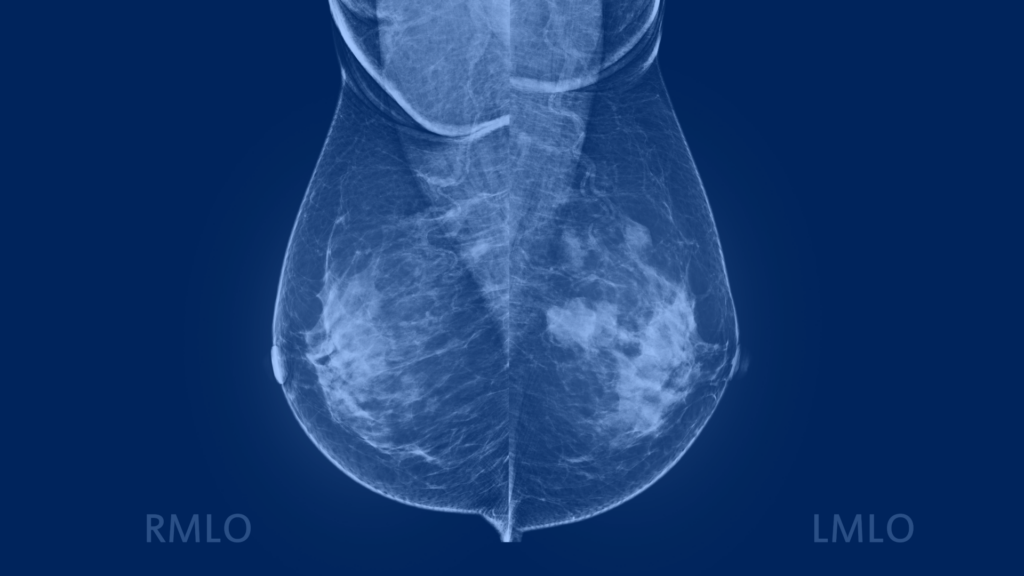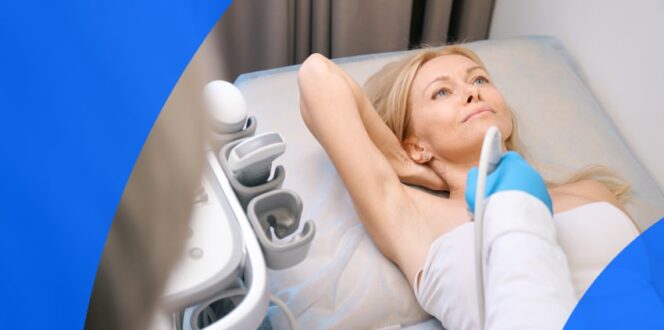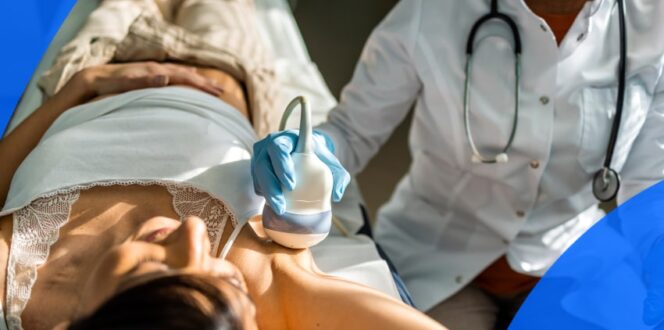What You Need to Know About Diagnostic Mammograms and Breast Cancer

If your screening mammogram identifies a need for further investigation, you may be sent for a diagnostic mammogram. That doesn’t necessarily mean bad news.
Getting a diagnostic mammogram can be a stressful experience. You might have a diagnostic mammogram after an abnormal finding in your regular screening mammogram, or because you noticed some new or unusual symptoms in your breast. But a diagnostic mammogram doesn’t always equal bad news. Almost 50% of women who get annual mammograms will experience at least one false positive over a ten-year period.
Knowing why a diagnostic mammogram is ordered and what to expect can relieve some of that tension. This post will examine:
- What a diagnostic mammogram is and how it differs from a screening mammogram
- When to get a diagnostic mammogram and how to prepare for your scan
- Questions to ask during and after your mammogram appointment
- How to see and understand your ultrasound images and report
What is a diagnostic mammogram?
A diagnostic mammogram is a type of X-ray that uses a low dose of radiation to take images of breast tissue. Mammograms are the most common screening test for breast cancer, which is the second-most common source of cancer in women in both the U.S. and Canada.
Screening mammography monitors changes in breast tissue and detects early signs of breast cancer, often long before you feel any sort of symptoms. In 2023, the U.S. Preventative Services Task Force issued draft recommendations that women should begin receiving screening mammograms every other year starting at age 40.
There are several types of mammograms:
- Film mammogram is an analog X-ray of the breast.
- Digital mammogram is a computerized image of the breast created when an X-ray is converted into an electrical signal.
- 2D mammogram (S2D) is an X-ray of the breast from at least two different angles.
- 3D mammogram also known as digital breast tomosynthesis (DBT), is a three-dimensional image of the breast created from multiple X-ray images.
Screening vs diagnostic mammogram: what’s the difference?
A screening mammogram is a regular scan in which images are taken of both breasts to check for signs of disease in patients exhibiting no symptoms. Doctors use baseline mammograms to monitor changes in breast tissue over time. Mammograms can identify abnormal areas before you feel any signs or symptoms. According to the National Cancer Institute, mammograms are the most common screening test to detect breast cancer.
A diagnostic mammogram is performed to diagnose a specific area, lump or problem in the breast. The process takes a little longer than a screening mammogram, and will usually cover both breasts for comparison purposes. The radiologist or interpreting physician may be present, and any follow-up imaging may be taken right away.
Why would a diagnostic mammogram be ordered?
Having a diagnostic mammogram does not mean you’ll be diagnosed with cancer. According to a recent study of more than one million participants, 10.3% of women are recalled for further imaging after a regular digital screening mammogram in order to get more information. There are several reasons a doctor might order a diagnostic mammogram, including:
- Your screening mammogram showed an abnormal finding which needs further investigation.
- You have breast implants. Saline and silicone implants can occasionally impede the view of other breast tissue.
- You have very dense breast tissue, which can make it hard to distinguish any abnormalities.
- You or your doctor have noticed any symptoms in your breast that could be signs of cancer. Those include breast pain, a lump, nipple thickening or discharge, changes in breast size or skin texture.
Can a diagnostic mammogram identify cancer?
The American Cancer Society estimates that almost 298,000 women will be diagnosed with breast cancer in 2023. Health Canada notes that 82% of those cases will be detected early, in stage 1 or 2. The 5-year survival rate for breast cancer is 96.3%.
The mortality rate for breast cancer has dropped dramatically since 1989, down 43% by 2020. Screening and diagnostic mammograms lead to earlier detection, which makes for more positive health outcomes overall.
How to prepare for a diagnostic mammogram
There are some steps you can take to prepare for your diagnostic mammogram procedure:
- Bring your requisition with you. The requisition has important information for the imaging clinic or hospital.
- Use the same clinic. Whenever possible, have your mammograms at the same clinic each time. This will make it easier for the radiologist to compare images. Or speak to your doctor to get images from any previous mammograms to bring with you.
- Schedule your mammogram when your breasts are least sensitive. Your breasts may feel tender leading up to or during your menstrual cycle, so avoid making your mammogram appointment during these times. Many prefer to avoid 7-10 days before their period.
- Avoid deodorant or antiperspirant, and lotions. Don’t apply deodorant or antiperspirant on the day of your mammogram appointment, and make sure to wipe off any deodorant residue since the mammogram can pick up the aluminum. Also, avoid wearing powder or body lotion under your arms or your breasts.
- Remove long earrings or necklaces. It’s best to avoid wearing jewelry to your appointment because the metal can interfere with your images.
- Wear a top and bottom, rather than a dress. You will be asked to remove your top and bra during your mammogram, so wearing pants or a skirt may make you more comfortable during your appointment.
- Reduce your caffeine intake. Caffeine can make breast tissue more tender, so try to avoid—or limit—caffeine intake for 4-5 days before your appointment.
- Let the clinic know if you have implants. Breast implants require modifications to the mammogram process, so your appointment may take longer. Also let the technologist know about any changes or sensitive areas, or if you are breastfeeding.
- Obtain prior mammogram imaging. Speak with your doctor to get imaging from previous mammogram clinics so that you can bring the imaging to your new appointment or request that your doctor send the imaging to the clinic prior to your appointment. PocketHealth helps you keep your medical imaging securely organized together, so you can bring them to your appointments yourself or share them at referral appointments. Having all your mammogram imaging in one place lets you easily monitor different imaging results over time.
The imaging clinic or department will provide wipes to clean up after your screening, but you may wish to pack deodorant or antiperspirant to bring with you to wear after the appointment. Also, if you are concerned about pain during your appointment, ask your doctor if over-the-counter medication can help reduce discomfort.
Questions to ask during and after your diagnostic mammogram scan
The technician is not allowed to answer questions about the results of your diagnostic mammogram. But feel free to ask questions about the process and procedure, including:
- Will this be different from my last mammogram? How?
- How long will this scan last?
- Will the procedure be uncomfortable or painful?
- How can I let you know if the pressure becomes too much?
- When will my physician get the results?
- How can I access my images and report?
Afterward, the radiologist will review and interpret your results, forwarding a full report to your referring physician. At your follow-up appointment, you can ask your doctor more specific questions, like:
- What were the findings?
- Do I need further breast imaging, like an ultrasound or MRI?
- Is a biopsy recommended?
- What are the next steps?
How to access your diagnostic mammogram results
After a diagnostic mammogram, you’ll likely be eager to access your images and report as soon as possible. PocketHealth offers you access to your medical images and reports as soon as the radiologist releases them, often before you have a follow-up appointment with your referring physician. Access your records here.
PocketHealth lets you access, view and store your medical images and health information in a single, secure location. You can also use PocketHealth to share images, which can be helpful if you receive a diagnosis and want a second opinion.
The information in your diagnostic mammogram report can be difficult to understand. PocketHealth Report Reader helps you make sense of complex medical terms and definitions. Report Reader also automatically lets you know if there’s a follow-up recommendation in your reports. So you’ll always be aware of the next course of action, whether that’s additional imaging or a follow-up with a specialist.
What can you see in a mammogram image?
In a diagnostic mammogram image, your breast tissue shows up in shades of gray against a black background. Dense breast tissue and glands appear white. Calcium deposits, or calcifications, are visible as white flecks of various sizes. Cysts are fluid-filled structures with thin outer walls.
A tumor will appear as a concentrated white shape. Having a tumor does not mean you have cancer. Fibroadenomas are benign tumors that tend to shrink as you age, so they’re more common among women in their 20s and 30s.

A mammogram image showing malignant tumors in both breasts, which are categorized as BI-RADS category 4.
Making sense of a diagnosis
A diagnostic mammogram is used to clarify a previous finding or to examine areas presenting symptoms. It can illuminate calcifications, explore masses, or measure asymmetries. None of those findings automatically mean cancer.
Doctors use a specific standard vocabulary to explain mammogram results, called the Breast Imaging Reporting and Data System (BI-RADS). BI-RADS has seven numbered categories:
- Category 0: scan was incomplete or unclear, and you will need further testing, which might include another mammogram for comparison.
- Category 1: a normal test result, considered ‘negative’ in that nothing abnormal or new was detected.
- Category 2: also a negative test result, which includes some sort of non-cancerous finding like a benign calcification.
- Category 3: a possibly benign scan but one which reveals a finding that suggests a follow-up image be taken, generally within the year.
- Category 4: a suspicious finding which is not confirmed to be cancer. A biopsy is often recommended.
- Category 5: these findings typically suggest cancer: a biopsy is strongly recommended.
- Category 6: this category is only used for findings taken after cancer has already been proven.
Benign vs malignant findings
Many findings, like cysts and fibroadenomas, are normal occurrences. Findings can generally be divided into 3 categories:
- Benign: contains no cancerous cells
- Pre-cancerous: contains cells that have the possibility to become cancerous
- Malignant: contains cancerous cells that can spread to other tissues or organs
Next steps: preparing for additional diagnostic tests
Depending on the BI-RADS results of your diagnostic mammogram, you may need some further testing to assess or diagnose cancer or other conditions, such as:
- Biopsy: a sample of breast tissue is removed to check for cancer or other diseases.
- Blood test: doctors use several types of blood tests to help diagnose cancer, including a complete blood count (CBC), a test that searches for tumor markers, and/or one that examines blood proteins.
- MRI: magnetic resonance imaging uses magnets and radio waves to create highly detailed images of the inside of the breast.
- Ultrasound: sound waves create images of breast tissue and can measure changes in blood flow.
If you do get a cancer diagnosis, these tests will provide more information about the cancer’s type and severity. The test results, along with the symptoms you’re experiencing, will help your doctor decide which treatment options might be best for you.
The importance of early detection and timely treatment
The last three decades have witnessed a substantial drop in breast cancer mortality among women, largely due to effective early screening. Regular screening mammograms and diagnostic mammograms are highly efficient detection measures that can catch breast cancer at its earliest stages.
Not every finding in a diagnostic mammogram is cancer. However, the earlier cancerous and precancerous findings are caught, the easier they are to treat and the higher the survival rate.
If you have breast cancer and are looking for more information, the following resources may help:
How PocketHealth works
Learn more about how to use PocketHealth to access and share your mammogram records.
Published: September 5, 2023
Trusted by more than 800+ hospitals and clinics.



















